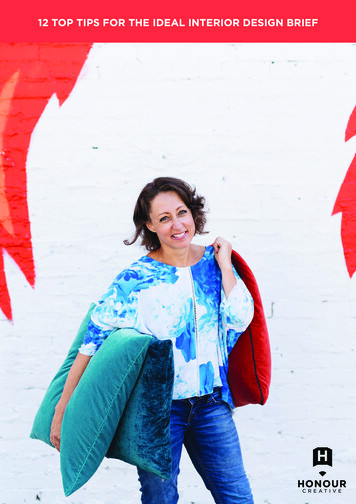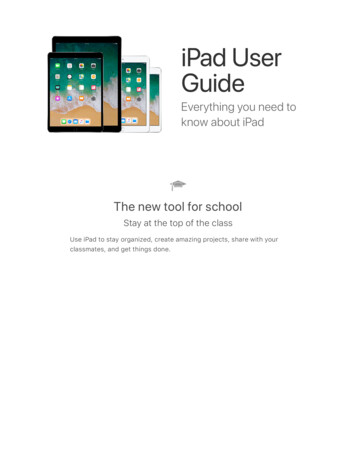
Transcription
12 TOP TIPS FOR THE IDEAL INTERIOR DESIGN BRIEF Honour Creative 2018
A critical part of the residential interior design process is the Design Brief. Your brief will form thefoundation for your interior design project, encompassing not only your likes and dislikes but your hopes,dreams and expectations for your interior space. By creating a design brief, you and your designer willhave a clear understanding of the requirements of your project. Committing some time and thought atthe start of your project can save you a whole load of time, money and stress later!Not sure what to include?The pointers and questions included here are typical of how we approach a design brief for a newHonour Creative client. Use these to generate some ideas for your project, complete our handy templateand your perfect interior design brief will be done in no time and you’ll be ready to move on to the nextstep in your project: finding an interior designer.Looking for guidance for a commercial project? The basic considerations are similar but the objectivesfor work or community spaces will obviously be quite different, so give me a call on 027 474 9194to discuss. Honour Creative 2018
12 TOP TIPS FOR THE IDEAL INTERIOR DESIGN BRIEFWRITING THE BRIEF1.As with any project, let’s start with your objectives; what do you want to achieve? Consider howyou want the space to look how it works and functions for you (and your family) and how it willmake you feel.2.Identify your interior design style. If you’re unsure about what that is, think about other areas inyour life where you feel more confident about your style. What do you like to wear? Where doyou like to shop, eat out, relax? Homes, like our clothes, are an extension of ourselves and, likeour clothes, the better they fit our true selves and lifestyle, the more comfortable and confidentwe feel in them. Are you a dedicated follower of fashion for example, an easy, breezy, comfy andrelaxed guy/gal or do you prefer classic lines and tailored clothing?3.Become aware of how you operate within your existing space; what does and doesn’t work?Interior design encompasses the functioning of the space as well as how it looks and feels — andif there are aspects of how your space functions that inhibit or irritate you, your space will neverfeel right, no matter how great it looks!4.How do you want the spaces to relate to each other? Should they feel distinct to emphasise aspecial use or should they tightly match to create a larger overall impression?5.Does the scope of your brief include space planning? For example, the number and uses ofrooms, who uses the spaces, at what times and for how long?6.What words and emotions would you like to evoke in yourself and others when entering your home?Consider what would be the ultimate compliment to you when friends first see your new space.7.Identify key places where you have felt truly happy. This may be holiday spots, previous homes,even work! What is/was it about these places that felt ‘right’?8.Find images that help capture the mood, contain a detail or feature a colour that you respond to.You might even identify some features you don’t like! Being clear about what you don’t like is justas important as identifying what you DO like.9.What likes/dislikes are shared amongst all members of your household and what are you not inagreement about? The planning stage is generally the best time to tackle these inconsistencies.10.Identify your heating, cooling and ventilation requirements and the impact of natural light on yourspace(s) — do you want more or less?11.Budget. Be very clear about how much money you want to spend on your project.12.Timeframe. When would you like the project to start? Is there a specific deadline for completionof the project or are you fairly relaxed about timeframe? Is there a specific reason for a deadlinesuch as family visiting from overseas for example.Finally, in the words of the song “Two out of three ain’t bad.” In my 20 years’ experience in the field of design, when considering time,budget and quality you can realistically only have two. So please be wary of any interior designer whopromises all three (tight timeframe, superior quality and low budget). You’re likely to be disappointed. Honour Creative 2018
12 TOP TIPS FOR THE IDEAL INTERIOR DESIGN BRIEFA DESIGN BRIEF TEMPLATESCOPEThe rooms or spaces included in this project are:The features of those spaces are in scope are: (For example: layout, lighting, heating, window treatments,flooring, fixed joinery, wall colours or finishes, appliances, technology, furniture.)FUNCTIONThe people (and pets) living here are: (Consider who is in the home permanently, now and in the future, temporaryguests? How often?)These are the different ways we use the space/s in scope:In our existing space/s the things that work well are:In our existing space/s the aspects that don’t work well are:GOALSWhat I/we would like to achieve with this new home or renovation is:We plan to live in this house for:My/our priorities, in order, are: (For example, sustainable products and practices, time, budget, top quality andcustomised design features)I/we are most excited about:I/we are most unsure or nervous about: Honour Creative 2018
12 TOP TIPS FOR THE IDEAL INTERIOR DESIGN BRIEFA DESIGN BRIEF TEMPLATEAESTHETICSWhen I/we enter our home I/we would like to feel:Features I/we really don’t like in our existing space/s are:Places I/we feel comfortable in are:Things that bring me/us joy are:The colours I/we like to be around are:RESOURCINGOur budget is:The amount of time I/we expect to contribute to this project each week is: (How available or flexible are youduring the normal working week?)The specialist skills I/we intend to contribute to this project are:Suppliers or other consultants I/we would like to work with on this project are:TIME FRAMEI/we would like this project to be completed by: (What is driving that deadline?)Other time related considerations are: (For example scheduled holidays, other time pressures)Answering these questions, or being prepared with the answers for your first meeting, will allowyour designer to better understand your needs. They will then be able to ask more specific questionsrelevant to your project. Honour Creative 2018
ABOUT THE AUTHORFRANCES FRASER“To me, a well-designed space should work well and feelgreat. We want our clients to love their new space everytime they are in it, not just the first time they walk in. I’msomeone who designs for people. I’m genuinely interestedin who they are – what makes them happy, their aspirations,how they do things and what would make a real differencein their everyday life.When things are done with heart, it shows.My experience in the graphic design industry (before I trained as an Interior Designer) taught me howto blend creativity with discipline. It gave me the skills to manage a project through from start to finishand work to timelines and budgets. Creatively, it also showed me the power of establishing the core ideaearly on and staying true to it every step of the way. It’s an approach I bring to my interior design work.We are all affected by our environments. nA space in harmony with the people that inhabit it, and the way they live, work or play, will alwaysdelight and endure beyond any current trends.vI’d love to work with you to create a space that works in harmony for you and your family!Just email me your completed design brief to frances@honourcreative.com or give me a call on027 474 9194. Honour Creative 2018
A critical part of the residential interior design process is the Design Brief. Your brief will form the foundation for your interior design project, encompassing not only your likes and dislikes but your hopes, dreams and











